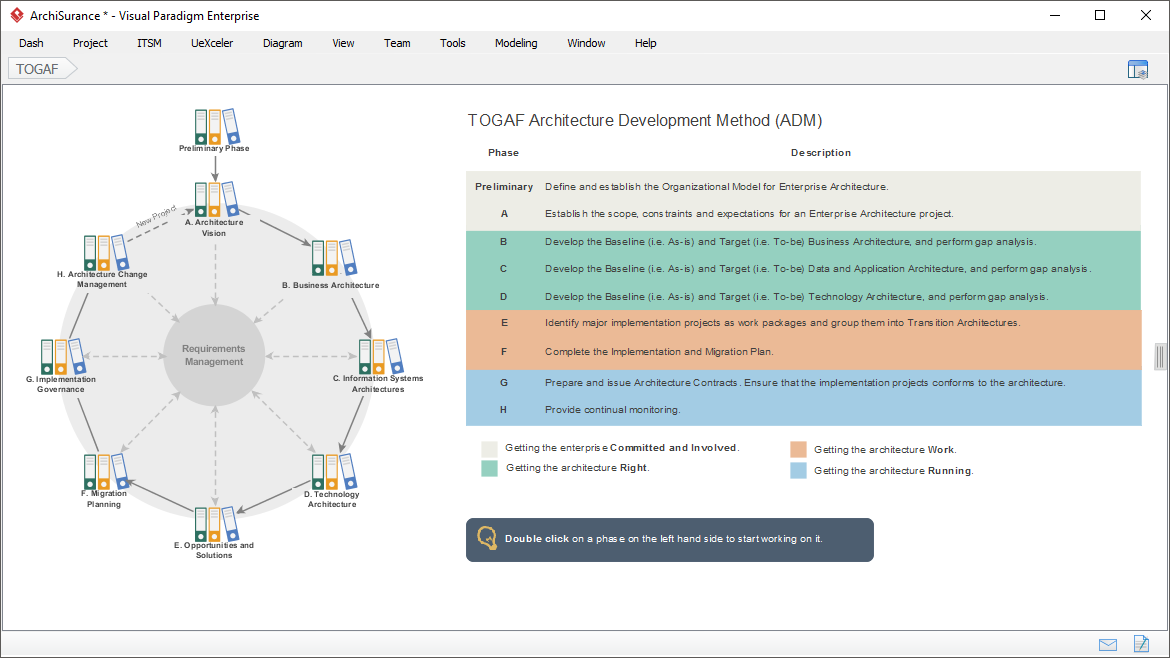Accelerating Enterprise Architecture: Visual Paradigm TOGAF’s Jump-Start Guide
Let’s delve into the reasons why various enterprise architecture (EA) terms adopt the TOGAF Architecture Development Method (ADM) and how it can be adapted to suit specific needs. 🌟
Why Adapt the TOGAF ADM?
-
Maturity and Order of Phases:
- The order of phases in the ADM depends on the maturity of the architecture discipline within an enterprise.
- For instance, if the business case for architecture isn’t well recognized, creating an Architecture Vision becomes essential. Detailed Business Architecture often follows to underpin the vision and engage stakeholders.
- Enterprises may prefer a different order based on their specific context (e.g., inventory of baseline environment before Business Architecture).
-
Alignment with Principles:
- Business principles and architecture principles influence the order of phases.
- If business principles prioritize agility (e.g., adjusting processes for packaged solutions), the Business Architecture may follow Information Systems Architecture or Technology Architecture.
-
Integration with Other Frameworks:
- Enterprises may integrate TOGAF with other frameworks (e.g., Zachman® Framework).
- The ADM is designed for such integration, allowing alignment with sector-specific deliverables (e.g., Government, Defense, e-Business).
-
Corporate Governance and Program Management:
- The ADM contributes to corporate governance models.
- It complements standard program management processes (authorization, risk management, planning, budgeting, etc.).
-
Outsourcing and Tailoring:
- When mandated for use by contractors, the ADM can be tailored to balance existing practices and enterprise requirements.
- Small-to-medium enterprises may prefer a more streamlined approach due to resource constraints.
- Complex enterprises with interlinked business frameworks adapt the ADM to recognize their unique structure.
Unlocking the Power of Visual Paradigm for EA Initiatives
1. Ease of Getting Started:
- Visual Paradigm provides detailed instructions, input references, and samples for each phase of the TOGAF ADM.
- Even teams with limited EA expertise can kick-start projects more easily using this guided process1.
2. Collaborative EA Development:
- Stakeholders across business and IT can collaborate effectively.
- Visual Paradigm supports both TOGAF and ArchiMate standards, providing a common language for cross-functional teams1.
3. Streamlined EA Deliverables:
- Instead of creating EA deliverables from scratch, Visual Paradigm automatically generates necessary artifacts.
- These include enterprise architecture models, roadmaps, and repository documentation, saving significant time and effort1.
4. Traceability and Governance:
- Visual Paradigm includes built-in task management and notification features.
- Full traceability allows teams to track architecture evolution over time1.
5. Certified ArchiMate 3 Support:
- As a certified ArchiMate 3 tool, Visual Paradigm ensures compliance with industry standards.
- It provides robust modeling capabilities to describe enterprise structure and behavior1.
In summary, Visual Paradigm’s TOGAF ADM Guide-Through Process streamlines EA initiatives, automates key deliverables, and drives real business value. It’s an invaluable tool for organizations embarking on their enterprise architecture journey1. 🚀
Feel free to explore more about Visual Paradigm and its practical implementation! 😊


